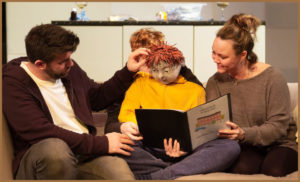Unless you have been living under a rock, you might have noticed that there has been a lot of unrest within the autism community recently, as All in a Row: theatre’s latest attempt to depict autism, has gone down pretty much as well as you would expect a show using a puppet to depict a marginalized group would.
However, despite this unrest, leading to distress and then finishing in a protest (I swear to God I did not intend that to rhyme), I have done my best to keep out of the movement, as I held out hope that this play (which by all accounts has been created to support the autism community) could become the poster child for not judging a book by its cover – boy was I wrong.

All in a Row Review
One thing I want to make clear from the get-go is that I actually quite like the premise of All in a Row (in fact, I like it a lot). A short, isolated story, set in a family’s living room, All in a Row takes place on the night before autistic child Lawrence is sent to a residential home – after an anonymous tip to social services has convinced them he would be better off away from his parents.
To me, this narrative seems like an excellent platform for discussing the many challenges autistic people and our families can face. When you add to this the fact that there really is some incredible talent on display here – with EastEnders’s Charlie Brooks being a particular highlight, then it becomes clear that all the pieces to the puzzle are there, it’s just a shame that writer Alex Oates falls short of getting them, well, all in a row.

Where does All in a Row go Wrong?
To put it bluntly, the character’s in All in a Row are wretched: they are disgusting to each other, their opinions are vile and even the character intended to be ‘good’ is made repugnant by his belief that all autistic people are reincarnations of animals.
Clearly these revolting character decisions were put in place to make moments of revelation seem more grandiose but, when a confession of love for a character comes moments after they just announced that they defecated into their ‘loved’ one’s pillow, then these words feel shallow – especially when they display no signs of remorse for blaming these incidents on the autistic Lawrence.
There’s an old proverb in theatre which goes ‘show don’t tell’ and I feel it’s one All in a Row should have adhered to (although not when referring to the pillow poo).

Should Lawrence have been played by an Autistic Actor?
But to the heart of the matter (or lack of). When following the controversy surrounding All in a Row, it seems that most of the hate it is receiving is in relation to its non-existent use of autistic actors and, instead, its portrayal of autism via a creepy puppet. I know this isn’t going to win me any favours but, frankly, this is something I couldn’t care less about.
Personally, I believe that all puppets are creepy, so let’s draw a line under that, and while I would love to see more autistic actors given a shot, I have to ask: Why would anyone want to see an autist star in a play where, night after night, they would have their identity dragged through the mud to an audience which, on the evening I attended, openly laughed at Lawrence being called a pitbull? It would be degrading.
I can see you all getting ready to light your torches and grab your pitchforks for this one but, while I’m already digging my grave, I want to add that I also think All in a Row could have benefitted from having more puppets, not less.
Lawrence is made into and treated like a monster because of the disconnect his puppet status lends him. I stand by the idea that, if All in a Row had chosen to give him a non-autistic puppet sibling, it could have been an incredible opportunity for audiences to perceive him as not as an outcast but as someone who is a brother, with a real place in the family. This would have given an explanation as to why every other character in the play was horrible, as there could be a sense of dramatic irony in that the two ‘creepy’ puppet characters could actually have the most heart.

In the end, this doesn’t matter though as, even when the National Autistic Society made recommendations on how to enhance the play (and make it less offensive), it fell on deaf ears. All in a Row’s biggest problem isn’t its awful characters, its wasted opportunities or strange design decision, but it’s the unwillingness to learn, change or alter – even when faced with a petition of nearly 20,000 people.
I do still believe there is a story worth telling in All in a Row though, it’s just a shame that this stubbornness means we’ll never see it. Instead, All in a Row is left it with an irredeemable legacy which has rightly caused outrage to many and, other than some very strong performances, the play’s only strength is its relatively short run time.

Carry on the Conversation
Have you seen All in a Row? If so, I would love to hear your thoughts in the comments below. And, if you would like to hear more on my beliefs regarding autistic actors playing autistic characters, please click this link and check out my discussion on just that: Should Autistic Actors play Autistic Characters?
As always, I can also be found on Twitter @AutismRevised and via my email: AutisticandUnapologetic@gmail.com.
If you like what you have seen on the site today, then show your support by liking the Autistic & Unapologetic Facebook page. Also, don’t forget to sign up to the Autistic & Unapologetic newsletter (found on the sidebar on laptops and underneath if you are reading this via mobile) where I share weekly updates as well as a fascinating fact I have found throughout the week.
Thank you for reading and I will see you next Saturday for more thoughts from across the spectrum.


